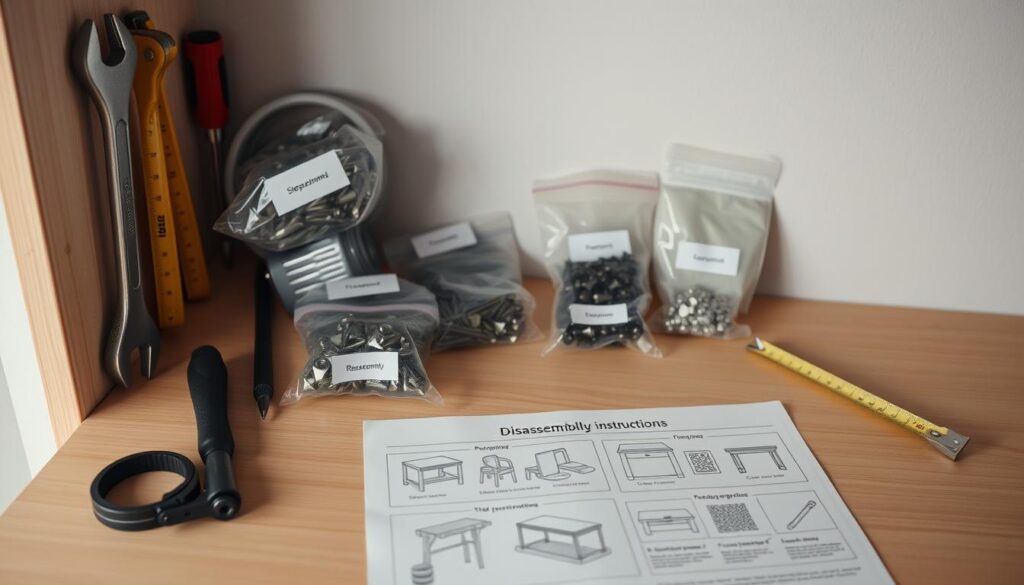Do movers disassemble things?
Get Your Free Moving Estimate
When preparing for a move, a common question arises: “Do movers disassemble things?” At HeavenlyMove, we understand the intricacies involved in professional moving services, including furniture disassembly. Our commitment to ensuring a seamless and stress-free relocation experience leads us to offer comprehensive disassembly and reassembly services. With over 20 years in the business and a stellar 4.9-star Google rating, we are dedicated to delivering exceptional service when it matters most. Disassembling furniture often plays a crucial role in safeguarding your belongings during the move.
Key Takeaways
- Professional moving services often include furniture disassembly.
- Disassembly helps in safer transport and packing of items.
- Experienced movers simplify the process for a stress-free move.
- Effective communication with your moving company is essential.
- Understanding what movers disassemble can streamline your relocation.
Understanding the Role of Movers
As you prepare for your upcoming move, grasping the role of movers proves essential. They deliver comprehensive services that simplify the whole process. When you engage professional moving services, you gain access to skilled personnel who manage everything from packing to transportation, making your relocation smoother and less stressful.
What Services Do Movers Provide?
Movers offer a wide array of services designed to meet diverse needs. Common offerings include:
- Local and long-distance moving
- Packing and unpacking
- Disassembly and reassembly service
- Relocation assistance for businesses
Each of these services ensures that your transition to a new space remains organized and efficient.
Common Items That Movers Disassemble
Furniture disassembly plays a crucial role in the moving process. Experienced movers typically disassemble items such as:
- Beds
- Dining tables
- Desks
- Cabinets
This service protects your belongings and allows for safer transport, minimizing the risk of damage during the move.
Why Disassembly is Important for Moves
Disassembly is not just about simplifying the moving process; it also addresses several essential factors:
- Easier transport through doorways and staircases
- Reduced storage space requirements
- Protection against potential damage
Understanding these aspects emphasizes the value of using professional moving services to take advantage of disassembly and reassembly services.
Furniture Disassembly: What to Expect
When preparing for a move, understanding the furniture disassembly process is vital. Knowing what to expect can alleviate stress and streamline the moving experience. Our team at HeavenlyMove specializes in providing moving help with furniture disassembly to ensure that every piece of your household is handled with care.
Types of Furniture Typically Disassembled
Various furniture pieces typically require disassembly to facilitate safe transport. Common items include:
- Beds: Bed frames often come apart for easier navigation through doorways.
- Dining Tables: Many tables can be separated from legs or extensions.
- Bookcases: These can generally be disassembled to save space.
- Sofas: Sectional sofas often need to be taken apart for efficient moving.
- Desks: Desks with drawers or complicated designs may require disassembly.
Tools Used for Furniture Disassembly
Efficient furniture disassembly requires the right tools. Some essential tools include:
- Power Drill: For quick removal of screws.
- Screwdrivers: Both flathead and Phillips for various screws.
- Wrenches: Helpful for loosening bolts and fasteners.
- Hex Keys: Commonly used for furniture assembly and disassembly.
Timeline for Disassembly During a Move
The timeline for household moving disassembly varies based on the size of the move, but generally follows this structure:
| Stage | Time Allocation |
|---|---|
| Pre-Move Planning | 1-2 days before |
| Disassembly of Large Items | 3-4 hours |
| Packing Disassembled Parts | 1-2 hours |
| Final Checks | 1 hour |
Benefits of Disassembling Before a Move
Disassembling furniture before a move provides essential advantages that make the relocation process smoother. Understanding the benefits of disassembling not only improves the safety of your belongings but enhances the overall efficiency of the move.
Easier Transport and Safer Packing
By opting for disassembly, we reduce the size and bulk of furniture pieces, making transport far simpler. This leads to safer packing, as smaller components can be stored more securely in the moving vehicle, minimizing the risk of damage during transit. Expert furniture removal services emphasize this strategy, ensuring everything arrives in optimal condition.
Protected Against Damage During Transit
Disassembling furniture can significantly protect items during transit. Smaller, well-packed parts are less likely to shift or sustain damage. The benefits of disassembling are evident when considering fragile pieces, as these often require careful handling. Keeping everything organized and separately packed minimizes the chances of scratches, dents, or breakage.
Time Savings During the Moving Process
When moves involve disassembled furniture, we often find that packing and loading occur much more efficiently. The process is streamlined, leading to time savings that can be crucial during a hectic moving day. Working with expert furniture removal professionals means you can rest assured that your items are being handled with care, while also saving valuable time in the process.
| Benefits | Description |
|---|---|
| Easier Transport | Smaller, lighter components lead to more efficient loading and unloading. |
| Safer Packing | Items can be securely packed with less risk of shifting during transit. |
| Damage Protection | Fragile pieces are better protected against scratches and breakage. |
| Time Savings | Streamlined process reduces overall moving time significantly. |
Preparing for Movers to Disassemble Items
Proper preparation for movers is crucial to ensure a smooth disassembly process. A little organization and communication go a long way in enhancing your moving experience. Here are key aspects to focus on when getting ready for your moving company disassembly.
Communicating with Your Moving Company
Open communication with your moving company helps clarify expectations. Here’s what to discuss:
- Disassembly Requirements: Ensure you understand what items need disassembly.
- Timeline: Inquire about when disassembly will occur in the overall moving timeline.
- Special Considerations: Mention any fragile or valuable items that require extra care.
Labeling Disassembled Parts and Pieces
Labeling is a straightforward way to keep track of all the parts. Consider the following tips:
- Use Clear Labels: Label each component with a corresponding furniture item.
- Bag Small Parts: Place screws and small parts in labeled bags to avoid misplacement.
- Instruction Sheets: Include assembly instructions in the bags for easy reassembly at your new place.
Ensuring Accessibility for Movers
Creating an accessible environment for movers contributes to efficient disassembly. Keep these points in mind:
- Clear Pathways: Ensure there are clear pathways for movers to navigate easily.
- Designate Disassembly Areas: Specify areas for furniture to be disassembled and packed.
- Ready Tools: Have necessary tools on hand for moving company disassembly, simplifying the process.

Implementing these strategies fosters a streamlined moving experience while preparing for movers to disassemble your belongings effectively.
Professional Movers vs. DIY Disassembly
Choosing between professional movers and DIY disassembly can greatly shape your moving experience. Understanding the benefits and drawbacks of each approach helps ensure a smoother transition to your new location. Let’s delve into the advantages of hiring professional movers and the risks associated with tackling disassembly on your own.
Advantages of Hiring Professional Movers
Engaging professional movers offers a range of advantages that enhance your moving process. Their expertise ensures that furniture is disassembled correctly and safely. Here are some key benefits:
- Time Efficiency: Professional movers complete disassembly much faster, allowing you to focus on other moving tasks.
- Specialized Tools: They come equipped with the right tools to handle various types of furniture.
- Experience: Their knowledge minimizes the risk of damage during disassembly and transport.
- Insurance Coverage: Many companies provide insurance for items handled, offering peace of mind.
Risks of DIY Disassembly
Opting for DIY disassembly may seem cost-effective but carries several risks. Missteps can lead to complications that ultimately increase the overall cost and effort of your move:
- Injury Risk: Using improper techniques or tools may result in injuries.
- Potential Damage: Incorrect disassembly can damage furniture, resulting in unexpected repair costs.
- Time Consumption: DIY tasks often take longer than anticipated, adding stress to your moving day.
- Lack of Equipment: You may not have access to the necessary tools or expertise, complicating the process.
Cost Comparisons: DIY vs. Hiring Movers
Understanding the cost implications of each option is crucial. Below is a breakdown that highlights the financial considerations:
| Cost Factor | DIY Disassembly | Professional Movers |
|---|---|---|
| Tools & Materials | Varies based on what you already own | Typically included in service fees |
| Labor Costs | Free if done yourself | Hourly rate, generally ranges from $80 to $150 |
| Insurance | None, you assume all risk | Coverage included in service |
| Time Investment | Often exceeds expectations | Quick and systematic |
Specialty Items: Additional Considerations
When it comes to moving, certain items require specialized care and handling. We understand the nuances involved in specialty items moving, ensuring each unique piece receives the attention it deserves. Our expertise extends to various high-value and delicate objects, all of which call for expert moving services.
Pool Tables and Pianos
Pool tables and pianos stand out as two significant categories among specialty items. Transporting these items necessitates skilled handling to prevent damage. Pool tables often need disassembly to transport safely, while pianos demand precision and expertise due to their weight and sensitivity. Our trained professionals are equipped to manage these challenges effectively.
Large Electronics and Appliances
Moving large electronics like televisions or appliances such as refrigerators involves unique considerations. It’s essential to properly secure these items to avoid internal damage during transit. We offer expert moving services tailored for large electronics, ensuring safe transport through every stage of the move.
Artwork and Fragile Items
Handling fragile items, especially artwork, requires meticulous care. Proper packing materials and techniques are essential in preventing damage. We take pride in our ability to securely package and transport delicate pieces, ensuring their arrival in pristine condition. Our dedication to specialty items moving shines in our careful approach to these treasured belongings.
What Movers Don’t Disassemble
Understanding what movers don’t disassemble is essential for ensuring a smooth moving experience. While many items may be taken apart by professionals, several significant pieces remain intact for various reasons.
Items Typically Left Intact
- Large appliances like refrigerators and washing machines
- Heavy furniture including sofas and beds
- Items with intricate wiring or components, such as electronics
- Highly fragile artwork and sculptures
Why Certain Items Are Not Disassembled
Movers often avoid disassembling specific items due to:
- Structural integrity: Some furniture pieces are designed for stability and breaking them down may weaken them.
- Time constraints: Disassembly can add significant time to the move and may not always be feasible within tight schedules.
- Special handling: Unique items require special care that professional movers are trained to execute without disassembly.
How to Handle Non-Disassemblable Items
When dealing with items that movers don’t disassemble, consider the following strategies:
- Prepare adequately by measuring doorways and hallways to ensure safe passage.
- Use professional packing strategies for handling large items, ensuring protection during transit.
- Communicate clearly with your moving company about any challenges or specific needs related to these items.
| Item | Reason for Not Disassembling |
|---|---|
| Refrigerators | Heavy and bulky, prone to damage if moved apart |
| Sofas | Maintains structure and design |
| Televisions | Intricate electrical components and wiring |
| Sculptures | Highly fragile, requiring careful handling as is |
Tips for Managing Disassembly and Assembly
Effective management of disassembly and assembly plays a crucial role in ensuring a smooth moving experience. By preparing properly, we can greatly reduce stress during the relocation process. Here are some moving tips that can help.
Documenting Each Step
Taking the time to document each step of managing disassembly can save a lot of headaches later. Consider the following:
- Use a checklist to itemize all furniture and items that require disassembly.
- Take photos of assembled items from different angles. This will serve as a visual reference when it comes time for reassembly.
- Note any specific instructions or requirements for reassembly, such as particular tools needed.
Using Proper Packing Materials
Utilizing the right packing materials can protect your belongings during the move and assist in managing disassembly. Important materials include:
- Bubble wrap for fragile items
- Furniture blankets to prevent scratches
- Zip bags for small hardware, ensuring nothing gets lost
Planning for Reassembly at Your New Home
Planning for reassembly is essential to minimize disruptions after the move. Focus on the following:
- Label boxes and parts clearly, indicating which items belong to each piece of furniture.
- Prioritize the order in which items will be assembled based on your immediate needs.
- Consider what help you might need for larger or more complex pieces during reassembly.

| Action | Benefits |
|---|---|
| Document Each Step | Helps with efficient reassembly |
| Use Proper Packing Materials | Protects items and reduces damage |
| Plan for Reassembly | Facilitates a quicker move-in process |
Questions to Ask Your Moving Company
When planning a move, it is essential to have a comprehensive understanding of the services offered by your chosen moving company. Asking the right moving company questions can make a significant difference in your overall experience. Here are some critical inquiries to consider.
Are Disassembly Services Included?
Inquire if the moving company provides disassembly services as part of their standard package. Knowing this beforehand helps you gauge the level of assistance available. Some movers include this in their service, while others treat it as an additional option, so confirmation is vital.
What Are the Extra Costs Involved?
Understanding the potential extra costs can prevent unexpected expenses during your move. Clarify any charges associated with disassembly services, packing materials, or additional labor. Get detailed explanations so you know how the final price may vary based on your specific needs.
What Happens If Something Gets Damaged?
Accidents can occur during a move, so it is important to ask what policies the moving company has in place regarding damages. Find out if they offer insurance options and how claims are handled. Knowing your rights and the company’s liability can give you peace of mind as you make your transition.
Do-It-Yourself Furniture Disassembly Tips
If you find yourself ready to tackle DIY furniture disassembly, we have some valuable tips for a seamless experience. With the right tools for disassembly and proper planning, you can efficiently manage the process at home. Follow these essential guidelines for a safe and successful disassembly of your furniture.
Essential Tools for Disassembly
Before you start, gather the necessary tools for disassembly. Having the right equipment will make the process smoother. Here’s a list of essential tools you should consider:
- Power drill
- Screwdriver set (both flathead and Phillips)
- Wrench or pliers
- Hammer
- Furniture dolly
- Measuring tape
- Zip bags for screws and small parts
Step-by-Step Guides for Popular Furniture
Dealing with various types of furniture can feel daunting. Here are basic steps for popular items:
- Couches: Remove legs, cushions, and any detachable parts to make moving easier.
- Beds: Disassemble the frame, taking apart the headboard, footboard, and slats. Keep hardware organized.
- Tables: Start with removing extra leaves if applicable. Disconnect the legs using your tools for disassembly.
- Bookcases: Unscrew shelves and disassemble the main frame carefully to avoid damage.
Safety Precautions to Consider
Prioritizing safety is crucial during DIY furniture disassembly. Take these precautions to ensure a safe experience:
- Wear gloves to protect your hands from sharp edges.
- Use eye protection if using power tools.
- Clear the area of any obstacles to prevent tripping hazards.
- Have a first-aid kit on hand for any minor injuries.
- Maintain a stable footing while lifting heavy items to prevent back injuries.
By following these tips, you can execute DIY furniture disassembly effectively. With the right tools for disassembly and a focus on safety precautions, you’ll navigate this task with confidence.
Moving Day: The Disassembly Process
Understanding what to expect on moving day is essential for a smooth transition. The disassembly process plays a critical role in ensuring that each item is transported safely and efficiently. Proper coordination with movers minimizes stress and time during this hectic day.
What Happens When Movers Arrive?
When movers arrive, they follow a structured protocol to initiate the moving day process:
- Initial Assessment: Movers evaluate the items to be disassembled.
- Checklist Review: They consult with you to confirm which pieces require disassembly.
- Protective Measures: Movers will use blankets and padding to safeguard furniture during the disassembly process.
Order of Operations for Disassembly
Each step in the disassembly process is conducted logically to ensure efficiency:
- Start with larger pieces such as beds and sofas.
- Proceed to disassemble smaller items like tables and chairs.
- Pack all disassembled parts and tools in clearly labeled boxes.
Ensuring Smooth Coordination with Movers
Effective coordination with movers is vital. Consider the following to enhance the moving day process:
- Maintain clear communication about any last-minute changes.
- Designate an area for packed items to reduce clutter.
- Be present to answer questions that may arise during the disassembly process.
| Stage | Task | Time Estimate |
|---|---|---|
| Arrival | Movers assess items | 30 minutes |
| Disassembly | Initial large furniture | 1-2 hours |
| Packing | Organizing disassembled parts | 30 minutes |
| Final Checks | Ensuring everything is ready for transport | 30 minutes |
Conclusion: Making Your Move Easier
As we wrap up our discussion, it’s vital to recap the key points about making your move easier. Throughout the article, we explored the importance of furniture disassembly, the benefits it brings in terms of transport and safety, and the resources available to guide you through the process. Whether you choose to hire professionals or tackle disassembly on your own, understanding the steps involved can significantly impact the smoothness of your move.
Recap of Key Points
Moving is undoubtedly a complex task, but effective planning can simplify it greatly. We focused on the role of professional movers, the types of furniture that typically need disassembly, and how to prepare for moving day. By communicating clearly with your moving company and ensuring accessibility, you can streamline the disassembly process and mitigate stress.
Next Steps for Planning Your Move
In moving resources, take the time to create a detailed checklist based on what you’ve learned. Consider your unique needs, assess whether to hire movers for disassembly, and get quotes from reputable companies. Engaging these services can provide peace of mind while ensuring that everything is handled with care.
Resources for Further Assistance
For more comprehensive moving resources, we encourage you to explore professional services that specialize in disassembly and relocation. Understanding all available options can enhance your planning for a successful move. With the right preparation and knowledge, you can transform what may seem like a daunting process into an organized and manageable venture.


